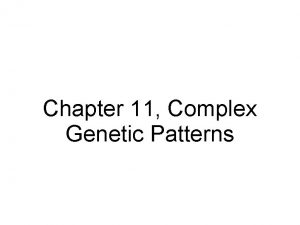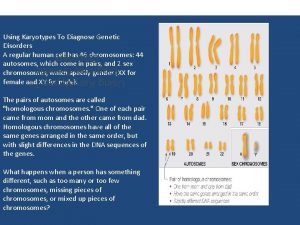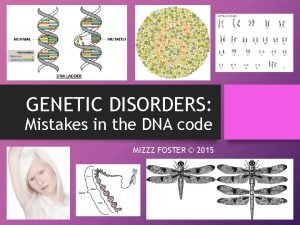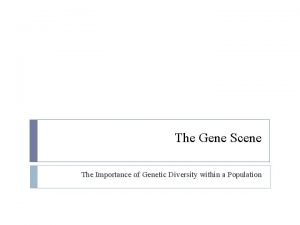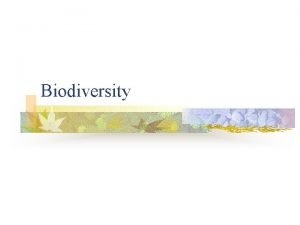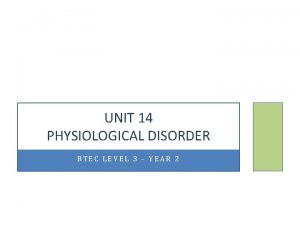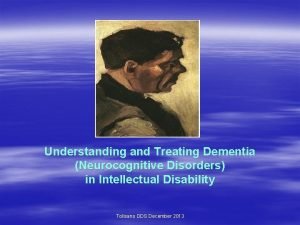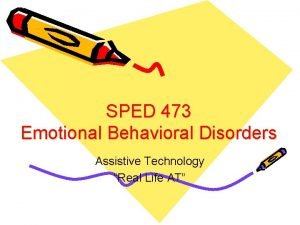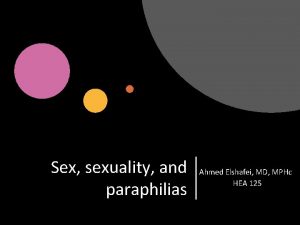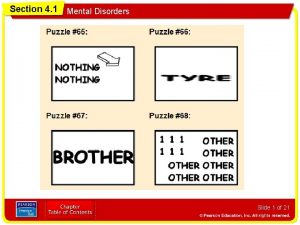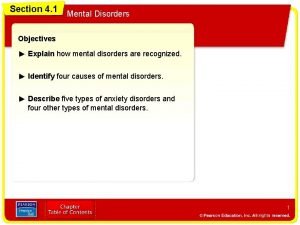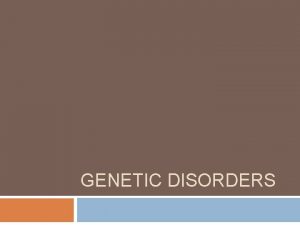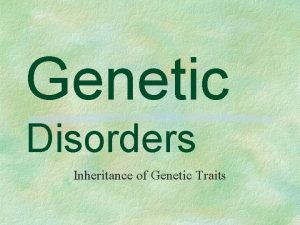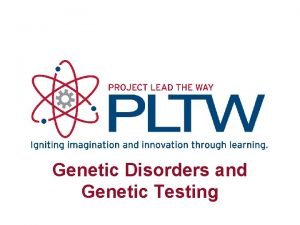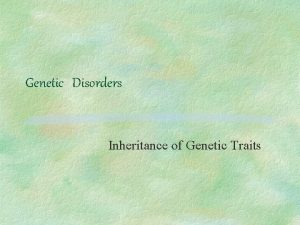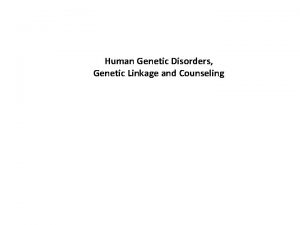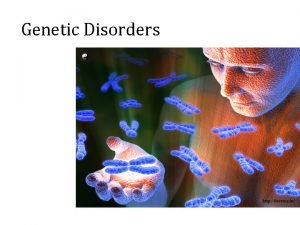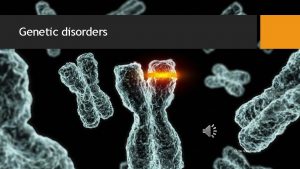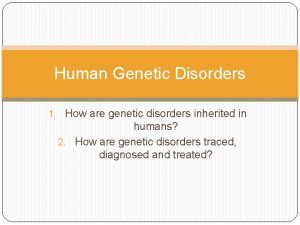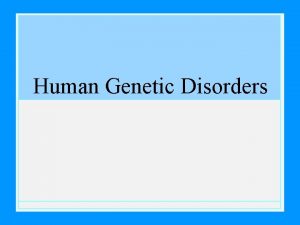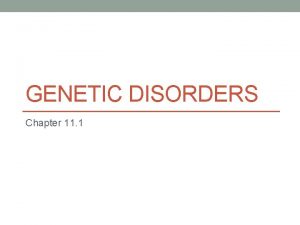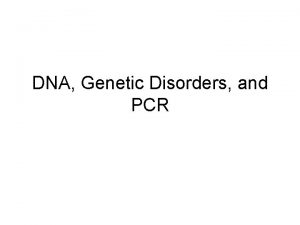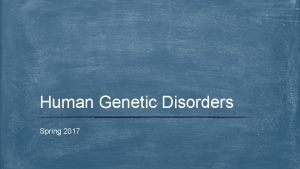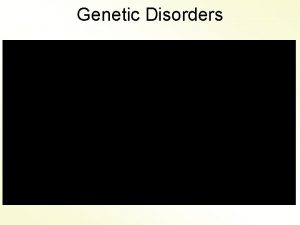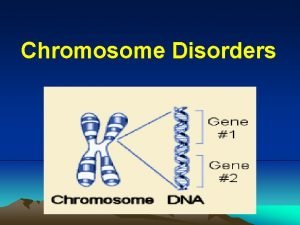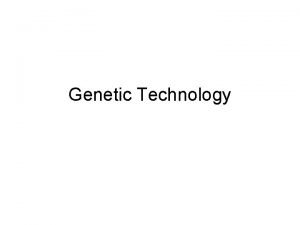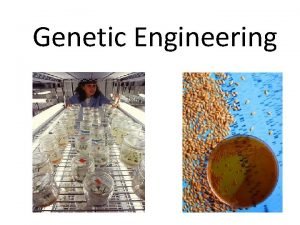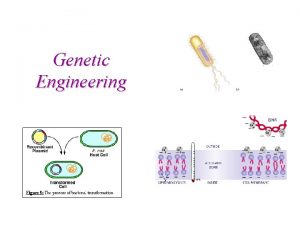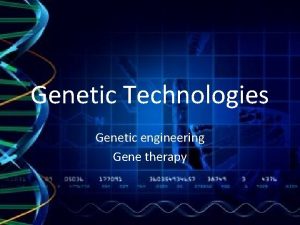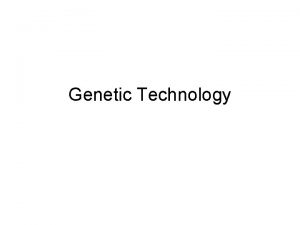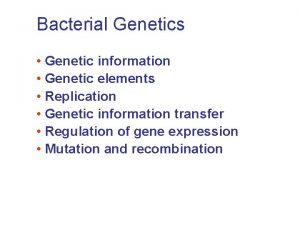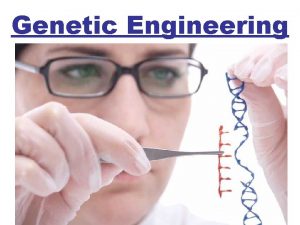Genetic Disorders What are genetic disorders Why do

































- Slides: 33

Genetic Disorders What are genetic disorders? Why do they occur? Who is affected?

MUTATIONS l Cause of mutations A. Exposure to toxic substances 1. Radiation: UV rays, x-rays 2. Chemicals: PCBs, DDTs B. Mistakes During MEIOSIS C. THEY CAN HAPPEN AT RANDOM

OUTCOMES OF MUTATIONS l Negative Effects- Change in DNA sequence leads to wrong protein produced = DISORDER l NO Effect- JUNK DNA- does not code for anything l Positive Effects- promotes characteristics that allow better survival =EVOLUTION

TYPES OF MUTATIONS l l Substitution- Substituting a base ATCAGCT= ATGAGCT Deletion-Deleting a base ATCAGCT =ACAGC Addition- Adding a base ATCAGCT= ATCCAGGCT Inversion- Flipping around a sequence of 3 Bases ATCAGCT= ATGACCT

GENETIC DISORDERS l HOW DO THEY OCCUR? – – SOMETIMES CHROMOSOMES FAIL TO SEPARATE CORRECTLY DURING MEIOSIS. THIS IS CALLED NON- DISJUNCTION.

SICKLE CELL ANEMIA l l l RBC’s shaped like a “C” Don’t carry oxygen easily RBC’s clump together Occurs in the African American Population Tiredness is often a symptom

DOWN’S SYNDROME l l l Extra Chromosome on # 21 Suffer mental retardation Short stature Simian crease on palm Epicanth Fold in eye

Down’s Syndrome l l Downs There is no cure for down’s. Prenatal tests such as karyotyping, triple screen blood test and …. . amniocentesis allow parents to find out before the child is born and prepare emotionally. Down’s syndrome patients have symptoms such as: heart abnormalities, small skulls, extra folds of skin under the eyes, large protruding tongue, and a flattened nose bridge.

KLINEFELTER’S SYNDROME l Extra X chromosome Male- XY l Female- XX l This is a male who has under developed sex characteristics l STERILE- can not reproduce. l (XXY)



TURNER’S SYNDROME l ONLY 1 X chromosome l This is a female with under developed sex characteristics. CHARACTERISTICS: Short stature, Webbed neck, Broad Chest, Increased weight gain, Sterile l



OTHER GENETIC DISORDERS l Achondroplasia(dwarf) l Cystic Fibrosis l Hemophilia l Progeria l Tay-sachs

Cystic Fibrosis

DIAGNOSING GENETIC DISORDERS l Amniocentesis- inserting a needle into the amniotic fluid to draw out infant cells l Genetic Counseling- Punnett Squares and pedigrees are constructed to determine the probability of two parents having an offspring with a genetic disorder

DIAGNOSING GENETIC DISORDERS l – Karyotyping Smearing out chromosomes, mapping them out, and looking for any abnormalities in chromosome number or structure.

KARYOTYPING

Pedigree Chart l Shows genetic relationships within a family.

ADVANCES IN GENETICS For centuries, humans have manipulated the genetic traits of organisms for our benefit. (disease removal or creating a superior species. )

HI MRS. HASTINGS!!!

Genetic Engineering l Types: l Selective Breeding – Choosing and mating organisms with the most desirable traits l Example- mating only the cows who have produced large quantities of milk. Also, mating the fastest race horses. l Inbreeding – Mating closely related individuals to obtain desirable traits

RECENT GENETIC ADVANCES GENETIC ENGINEERING POSITIVE ASPECTS OF GENETIC ENGINERRING Prevention of disease and death in humans Improved crop/ food production- less starvation Production of medicines/ reduction in the number of genetic disorders NEGATIVE ASPECTS OF GENETIC ENGINEERING If people continue to live longer, we complicated the overpopulation issue Long term negative consequences of genetically altered foods are unknown/ lack genetic variation Are we overstepping our bounds and playing ‘God? ’

HISTORICAL BACKGROUND l HYBRIDIZATION: l When individuals from different , but closely related species are mated to introduce new, beneficial alleles into a population. Example- the mule… a cross between a donkey and a horse. Is superior in strength, endurance, and resistance to disease. Usually are sterile (incapable of reproducing). l l

Gene Splicing l When DNA from two different species is joined together, it is called Recombinant DNA. l Biologists can cut, separate, and splice together DNA sequences in any order. l A 3 -Step Process: – – – Isolate a human gene Make Recombinant DNA Make the specific protein!

REAL LIFE EXAMPLES Gene Splicing- Inserting a human gene into a bacterial plasmid. The bacteria will then produce whatever protein the human gene coded for. example- human insulin


Cloning l Clones are organisms that have exactly the same DNA. l The human purpose of doing this is to produce large numbers of identical lab organisms which can be used for testing. (Ex. Mice, Frogs, Plants) Cloning body parts for transplantation with out rejection l

GENE THERAPY l l Gene therapy is an experimental technique that uses genes to treat or prevent disease. In the future, this technique may allow doctors to treat a disorder by inserting a gene into a patient’s cells instead of using drugs or surgery. l l l Researchers are testing several approaches to gene therapy, including: Replacing a mutated gene that causes disease with a healthy copy of the gene. Inactivating, or “knocking out, ” a mutated gene that is functioning improperly. Introducing a new gene into the body to help fight a disease.

RECENT GENETIC ADVANCES GENETIC ENGINEERING GENETICALLY ENGINEERED FOODS AKA GENETICALLY MODIFIED FOODS (GMO) l l Inserting a desirable gene from one organism into a food product for corporate benefit. l example- flounder gene inserted into tomatoes (we’ll discuss the pros & cons)

RECENT GENETIC ADVANCES GENETIC ENGINEERING l l l Gel Electrophoresis/ DNA Fingerprinting Used to diagnose disease Used for criminal identification Used to identify unknown bodies… this technique was useful in identifying victims of September 11 th. Involves separating DNA sequences on a charged gel according to their relative sizes and making a ‘picture’ of these sequences.

SMALLER GENES MAKE IT TO THE BOTTOM! http: //www. pbs. org/wgbh/nova/education/b ody/create-dna-fingerprint. html
 Insidan region jh
Insidan region jh Why why why why
Why why why why Concept mapping chapter 11 genetic disorders
Concept mapping chapter 11 genetic disorders Dominant vs recessive genetic disorders
Dominant vs recessive genetic disorders Using karyotypes to diagnose genetic disorders
Using karyotypes to diagnose genetic disorders Genetic disorders
Genetic disorders Gene pool
Gene pool Genetic programming vs genetic algorithm
Genetic programming vs genetic algorithm Genetic programming vs genetic algorithm
Genetic programming vs genetic algorithm What is gene flow and genetic drift
What is gene flow and genetic drift Genetic drift vs genetic flow
Genetic drift vs genetic flow Dont ask
Dont ask Why is genetic diversity important
Why is genetic diversity important What is ecosystem biodiversity
What is ecosystem biodiversity Why is genetic diversity important
Why is genetic diversity important Why-why analysis
Why-why analysis Wh tongue twister
Wh tongue twister Does this table represent a function why or why not
Does this table represent a function why or why not What does a table represent
What does a table represent Why or why not
Why or why not Contoh laporan root cause analysis
Contoh laporan root cause analysis Unit 14 health and social care coursework
Unit 14 health and social care coursework Health and social care level 3 unit 14
Health and social care level 3 unit 14 Neurocognitive disorder
Neurocognitive disorder Bipolar and other related disorders
Bipolar and other related disorders Bipolar and other related disorders
Bipolar and other related disorders Flinders model of care
Flinders model of care Assistive technology for emotional disturbance
Assistive technology for emotional disturbance Somatization disorder
Somatization disorder Egodystone
Egodystone Types of sensory disorders
Types of sensory disorders Section 4-1 mental disorders answers
Section 4-1 mental disorders answers Section 4-1 mental disorders answers
Section 4-1 mental disorders answers Puberty and autism spectrum disorders
Puberty and autism spectrum disorders



